Posted ,
Reading 3 mins.
The US federal public health agency announced on Thursday the first case of human infection with the H5 avian flu virus in the United States. An announcement which could seem worrying in the current context but which does not increase the risks for the general public.
The Centers for Disease Control and Prevention (CDC), the United States’ lead federal public health agency, reported the first human infection with the H5 bird flu virus in the state of Colorado on Thursday. April 28.
Fatigue as the only symptom
Infected birds shed H5N1 viruses in their saliva, mucus and feces. H5N1 virus infections in humans are rare. However, human infections can occur when enough of the virus comes into contact with a person’s eyes, nose or mouth, or is inhaled. People who have close or prolonged unprotected contact (not wearing respiratory or eye protection) with infected birds, or with areas that sick birds or their mucus, saliva or feces have touched, may be at increased risk of infection. infection with the H5N1 virus. Illnesses in people infected with the bird flu virus range from mild (eg, eye infection, upper respiratory tract symptoms) to severe (eg, pneumonia) that can lead to death.
The reported case occurred in a person under the age of 40, who participated in the slaughter of poultry infected with suspected H5N1 avian influenza. The patient had only one symptom: he reported being tired for a few days and has since recovered. He was isolated and treated with an antiviral drug against influenza, theoseltamivir.
Second human case in the world
This is the second human case associated with this specific group of H5 viruses and the first case in the United States. The first international case occurred in a man in December 2021 in the UK. His flock of poultry contracted the virus and the man tested positive for the virus, although he apparently did not show symptoms of the disease.
Although the patient is believed to be the second human case in the world, it is not entirely certain that the Colorado man was actually infected. CDC says test may have detected a virus “surface contaminant” – presumably a virus taken from a nasal swab – which was present due to the human’s involvement in the slaughter of infected poultry. But the federal agency said the individual met the criteria for a positive case and should be treated as such.
A low risk for the general public
“This H5-positive human case does not change the human risk assessment for the general public, which the CDC considers low. However, people who are exposed to infected birds through work or play are at higher risk of infection and should take appropriate precautions.” explained the CDC in its press release.
But what precautions are necessary? The CDC has put forward various measures:
- Avoid contact with poultry that appear sick or dead;
- Avoid contact with surfaces that appear to be contaminated with the droppings of wild or domestic birds;
- If you must handle sick or dead wild birds or poultry, minimize direct contact by wearing gloves and washing your hands with soap and water after touching the birds. If possible, wear respiratory protection, such as a medical mask, and eye protection, such as goggles;
- Be aware that proper handling and cooking of poultry and eggs to an internal temperature of 74 degrees kills bacteria and viruses, including the H5N1 virus.
The United States federal agency nevertheless continues to monitor H5N1 viruses to detect genetic changes associated with adaptation to mammals, which could indicate that the virus is adapting to spread more easily from birds to humans. human.
She thus announced that she had thought about preventive measures concerning the H5N1 virus, in particular the development of a candidate virus, which could be used to manufacture a vaccine for humans if necessary.
